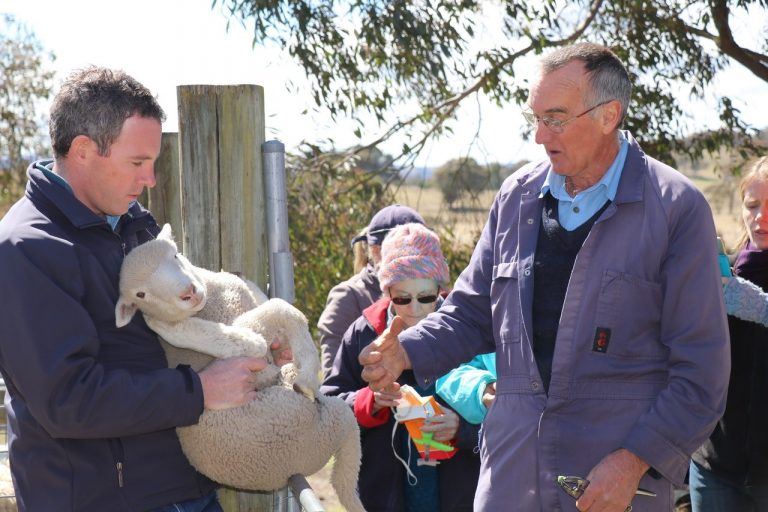Matthew Lieschke and Dr Bill Johnson from South East Local Land Services led the discussion and practical session about managing lambs and ewes at lamb marking. Lamb marking is a key animal husbandry task for people raising lambs and typically involves ear tagging, vaccination, castration and tail docking.
Key points
Plan to mark lambs at 2-8 weeks of age. Younger lambs are likely to recover faster. Lamb marking should be completed before the lambs are 12 weeks old. If you have lambs arriving over a long period, it might be better to have several lamb marking times. Marking before the end of October reduces the risk of fly strike.
Preparation of the site and equipment will help you to minimise infections. Generally a temporary holding pen out in a paddock is cleaner than the sheep yards and a good place to do marking. Avoid mud and dusty conditions. Cover surfaces where equipment is placed with a clean cloth or towel. You can use a lamb cradle or hold the lamb securely in your arms (see photo).

Disinfect any equipment between animals using Hibitane (Chlorhexidine). Push needles into a sponge soaked in the disinfectant solution after each injection. Note that most other types of disinfectants are deactivated by organic matter and need to be changed frequently.
Vaccinate each lamb at lamb marking with 5 in 1 or 6 in 1 vaccine for sheep with a follow up booster vaccination 4 weeks later. This is injected subcutaneously (under the skin) either in the neck or the brisket (if holding the lamb). Needles for sheep vaccinations should be sharp, 18 gauge and 6mm or 12mm long.
Lambs that will be kept for more than 2 years can be vaccinated with Gudair vaccine for lifelong protection against Johne’s Disease. Be careful with Gudair vaccine which can have bad side effects for people who accidentally touch or inject it.
[Options now available for reducing pain at marking include Numnuts and Buccalgesic - Ed.]
The recommended tail length for tail docking is three palpable joints. In ewe lambs, a tail of this length covers the vulva. Shorter tail lengths take longer to heal, can affect the movement of the tail and increase the likelihood of fly strike. If you are using lamb marking rings, the ring should be placed on the joint rather than the bone between joints, the tail will usually drop off in about 3-4 weeks.
Castration of male lambs is often done by placing a lamb marking ring over the scrotum, making sure that both testicles are included and that the teats are not included before releasing the ring into place (see ‘A producers guide to sheep husbandry practices’ below for more details).
Lambs need to have an ear tag with the Property Identification Code (PIC) if they will ever be moved off the property. The tag can also have other information such as a number for the flock or individual sheep and a V if vaccinated for Johne’s Disease. Different coloured ear tags are used for each year but this is not compulsory. Pink tags are only used to replace tags where a sheep was born on another property and has lost its tag. Use a tag applicator that matches the type of tags. Dip the tag in disinfectant before applying half way along and half way up the ear. A convention is that ewe lambs are tagged in their right ear, ram/wether lambs are tagged in their left ear.
After marking, allow lambs time to ‘mother up’ with the ewes. It can help to put the lambs in the middle of the paddock and then let the ewes out to the lambs and give them time to find each other. The male lambs will often lie down.
Plan to wean at 12-14 weeks of age. In tougher years, it can be better to wean earlier so that ewes can start to put weight on in preparation for joining. By 8 weeks old the lamb is getting less than 10% of its nutritional intake from milk. Wean lambs onto your best paddocks that have been rested for 3 months to reduce worm burdens and don’t have nasty grass seed heads. Lambs are usually given their first drench at weaning. Weaning is also a good time for the lambs’ booster vaccination (if it hasn’t already happened).
Further Information
A producers guide to sheep husbandry practices – Meat and Livestock Australia. This guide gives a comprehensive guide on best practice sheep husbandry and more detail on lamb marking procedures.
Sheep Ag Skills – A Practical Guide to Farm Skills
Sheep Weaning Best Practice (WA)
Early weaning and creep feeding of lambs in poor seasons (WA)
Creep feeding lambs (NSW DPI)
Options for weaning (Sheep 201)
This field day was made possible by funding from the Australian Government, in-kind support from South East Local Land Services and the Palerang Local Action Network for Sustainability. We thank them for their ongoing support.